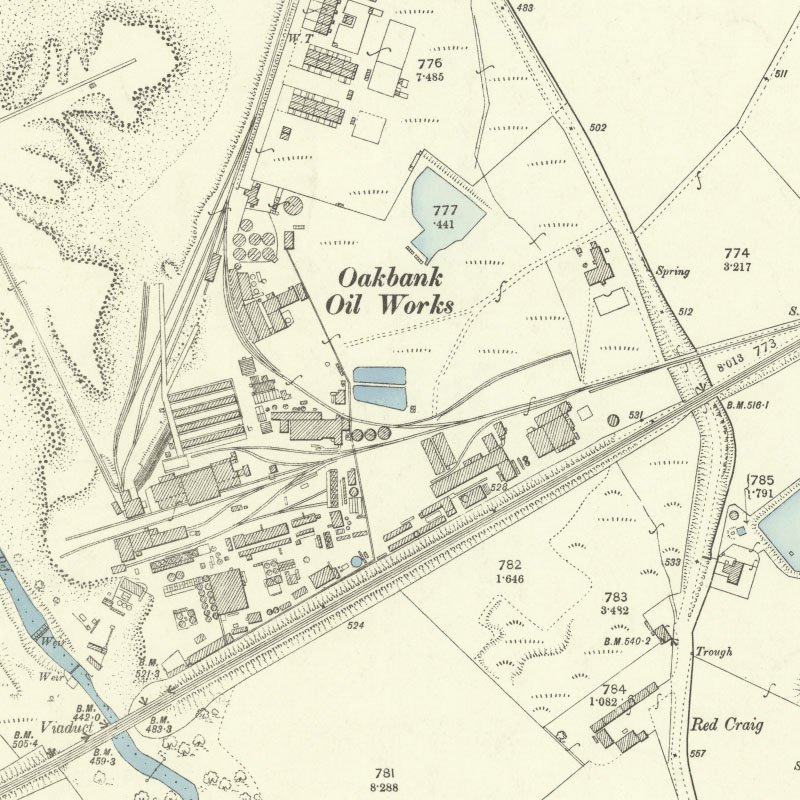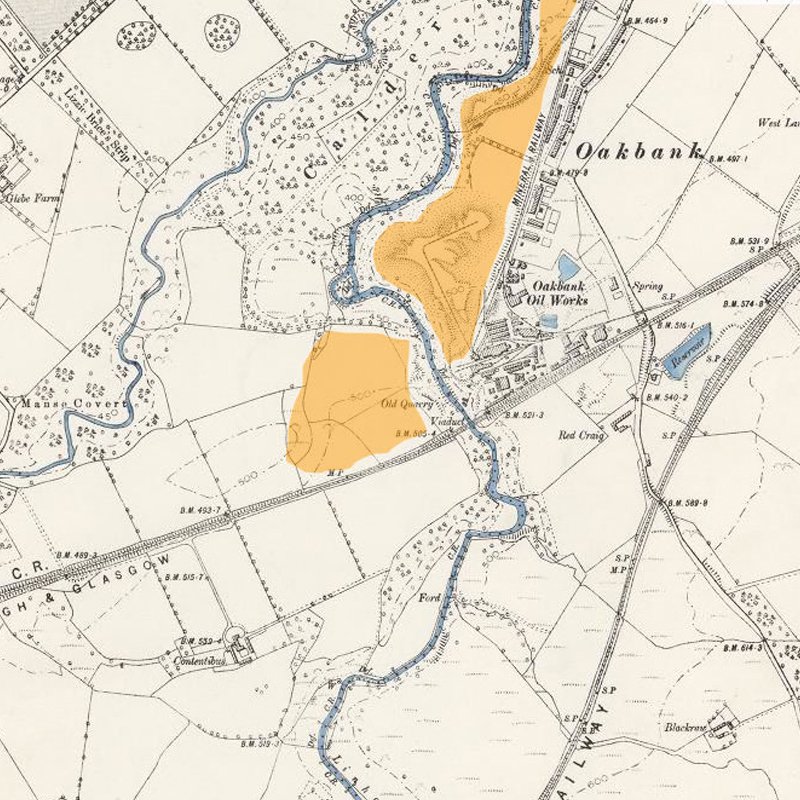- Aberdeen Oil Works
- Addiewell Oil Works
- Almondhill Oil Works
- Annick Lodge Oil Works
- Arden Oil Works
- Armadale Oil Works
- Auchenheath Oil Works
- Avonhead Oil Works
- Balgray Oil Works
- Ballat Oil Works
- Bathgate Oil Works
- Bathville Oil Works
- Bellsdyke Oil Works
- Bellsquarry Oil Works
- Benhar Oil Works
- Binnend Oil Works
- Birkenshaw Oil Works
- Bishop Street Oil Works
- Blackburn Oil Works
- Blackstone Oil Works
- Blackstoun Oil Works
- Blochairn Oil Works
- Boghall Oil Works
- Bredisholm Oil Works
- Breich Oil Works
- British Asphalte Oil Works
- Broxburn Oil Works
- Broxburn - Bell's Stewartfield Oil Works
- Broxburn - Albyn Oil Works
- Broxburn - East Mains Oil Works
- Broxburn - Greendykes Oil Works
- Broxburn - Hallfarm Oil Works
- Broxburn - Hutchinson's Oil Works
- Broxburn - Poynter's Oil Works
- Broxburn - Steele's Oil Works
- Broxburn - Steele's Stewartfield Oil Works
- Buckside Oil Works
- Burngrange Oil Works
- Calderbank Oil Works
- Canalbank Oil Works
- Champfleurie Oil Works
- Clippens Oil Works
- Cobbinshaw North Oil Works
- Cobbinshaw South Oil Works
- Coneypark Oil Works
- Craigie Oil Works
- Crown Point Oil Works
- Dalmeny Oil Works
- Deans Oil Works
- Doura Oil Works
- Drumbow Oil Works
- Drumcross Oil Works
- Drumgray Oil Works
- Dryflat Oil Works
- East Fulton Oil Works
- East Hermand Oil Works
- Eldin Oil Works
- Falkirk Oil Works
- Fergushill Oil Works
- Forthbank Oil Works
- Forth & Clyde Oil Works
- Gavieside Oil Works
- Grange Oil Works
- Grangepans Oil Works
- Greengairs Oil Works
- Hareshaw Oil Works
- Hartwood Oil Works
- Hawick Oil Works
- Hermand Oil Works (1866)
- Hermand Oil Works (1883)
- Holmes Oil Works
- Hopetoun Oil Works
- Hurlford Oil Works
- Inkerman Oil Works
- Inverkeithing Oil Works
- Kilrenny Oil Works
- Kilwinning Oil Works
- Kirkmuirhill Oil Works
- Kirkwood Oil Works
- Lanark Oil Works
- Lanemark Oil Works
- Levenseat Oil Works
- Limerigg Oil Works
- Linwood Oil Works
- Loanhead Oil Works
- Lochburn Road Oil Works
- Lochgelly Oil Works
- Longrigg Oil Works
- Magdalene Oil Works
- Methil Oil Works
- Millburn Oil Works
- Nettlehole Oil Works
- Niddry Castle Oil Works
- Nitshill Oil Works
- Oakbank Oil Works
- Palacecraig Oil Works
- Pathhead Oil Works
- Patterton Oil Works
- Pentland Oil Works
- Philpstoun Oil Works
- Port Dundas Oil Works
- Possil Oil Works
- Pumpherston Oil Works
- Raebog Oil Works
- Riggend Oil Works
- Rochsoles Oil Works
- Rochsolloch Oil Works
- Roman Camp - Almondfield Oil Works
- Roman Camp - Cawburn Oil Works
- Roman Camp Oil Works (1892)
- Roman Camp - Shale Oil Works
- Rosebank Oil Works
- Roughcraig Oil Works
- Rumford Street Oil Works
- Seafield Oil Works
- Shawsburn Oil Works
- Sheepford Locks Oil Works
- Shettleston Oil Works
- Shotts Oil Works
- Stand Oil Works
- Stanrigg Oil Works
- Stonehouse Oil Works
- Straiton Oil Works
- St. Rollox Works
- Swinehill Oil Works
- Tarbrax Oil Works
- Uphall Oil Works
- Uphall - Railway Oil Works
- Uphall - Wyllie's Oil Works
- Vulcan Chemical Works
- Wardend Oil Works
- Wattston Oil Works
- Westfield & Capeldrae Oil Works
- Westwood Oil Works (1941)
- Westwood Oil Works (1866)
- Whitebog Oil Works
- Whitehill Oil Works (Lanarkshire)
- Whitehill Oil Works (Midlothian)
- Whiterigg Oil Works
- Woodhall Oil Works
Oakbank Oil Works
Redwood noted:
"In 1860 Sir James Simpson started a work a Oakbank, Mid Calder, Midlothian, and after receiving fairly good returns on his investment for three years, he formed a private company which was very successful, and led to the oil work and mineral fields finally becoming the property of a limited liability company which was floated in 1869".
This is not wholly accurate. In 1864 Hare, Simpson & McKinlay, presumed partners in the Oakbank Oil Co. formed a limited company, the Midcalder Mineral Oil Co. Ltd. to take forward operations at Oakbank. This proved shortlived and in 1869 the Oakbank Oil Co. Ltd (1869), a new limited company with a new board of directors, was formed to take forward the business.
Redwood continued:
"The Oakbank company was very successful at the start, but the constantly decreasing prices for finished products, and the adoption of a bad form of retort, brought it to the verge of bankruptcy in 1886, and necessitated its reorganisation. The extension of the works and general reorganisation were completed in May 1887, after which an expenditure of £30,236, and the company was then placed on a more equal footing with its competitors."
Oakbank Paraffin Oil Works, (as it was originally known), was one of the earliest shale oil works. A newspaper account of 1865 mentions "a curious old retort in the glen, which was one of the first that was used in Scotland for the manufacture of crude oil from shale" This was separate from the the oilworks then in production. The works were initially served by small-scale shale workings in Calder Wood, then, from c.1868, by Oakbank No.1 & 2 pits, lying a mile north of the works and linked by the company's mineral railway. Oakbank No.1 and 2 pits remained the major source of shale for the works throughout the 19th century, but as the isolated Oakbank shale-field became exhausted the company had to look elsewhere for supplies. Newfarm No.3 &.4 mines, lying almost a mile to the west of Oakbank supplied shale between, c.1909 and c.1919, linked by a spectacular aerial ropeway. Shale was probably also transported from Westwood pit. The Oakbank Oil Company also established Niddry Castle Oil Works in about 1902, producing crude oil that was sent to Oakbank for refining. The workforce was accommodated in company housing in Oakbank village.
The works were demolished c.1932.
| Date | Rateable Value | Owner | Occupier | Notes |
|---|---|---|---|---|
| 1863 | £200 | Stuart Bailey Hare of Calderhall | Hare Simpson & McKinlay | Minerals |
| 1864 | £150 | Stuart Bailey Hare of Calderhall | Hare Simpson & McKinlay | Buildings at Paraffin Works |
| £200 | Stuart Bailey Hare of Calderhall | Hare Simpson & McKinlay | Minerals at Drumcrosshall | |
| 1865 | £163.16/- | Oakbank Oil Company Ltd | Oakbank Oil Company Ltd | Shale Works at Mid Calder |
| £417 | Stuart Bailey Hare | Mid Calder Mineral Oil Company Ltd | Minerals at Combfoot | |
| £300 | Lord Torphichen | William McKinlay | (Minerals listed in Parish of Mid Calder) | |
| 1866 | £230.5/- | Mid Calder Mineral Oil Company Ltd | Mid Calder Mineral Oil Company Ltd | Chemical Works |
| £300 | Lord Torphichen | William McKinlay | Minerals at Combfoot | |
| 1867 | £405 | Mid Calder Mineral Oil Company Ltd | Mid Calder Mineral Oil Company Ltd | Shale Oil Works |
| £796 | Lord Torphichen | William McKinlay | Minerals | |
| £150 | Lord Torphichen | William McKinlay | Minerals at Mid Calder | |
| 1868 | £200 | Mid Calder Mineral Oil Company Ltd | Mid Calder Mineral Oil Company Ltd | Works unlet |
| £300 | Lord Torphichen | William McKinlay | Minerals at Combfoot | |
| -- | Not listed | Not listed | Not listed | |
| 1869 | £300 | Mid Calder Mineral Oil Company Ltd | Mid Calder Mineral Oil Company Ltd | Works |
| £300 | Stuart B Hare | Robert Fraser | Minerals | |
| £300 | Lord Torphichen | Robert Fraser | Minerals at Calder | |
| 1870 | £895 | Oakbank Oil Company Ltd | Oakbank Oil Company Ltd | Works |
| £1156.7.5 | Stuart B Hare | Minerals | ||
| £300 | Lord Torphichen | Oakbank Oil Company Ltd | Minerals at Calder | |
| 1871 | £895 | Oakbank Oil Company Ltd | Oakbank Oil Company Ltd | Works |
| £1518.3.3 | Stuart B Hare | Oakbank Oil Company Ltd | Minerals | |
| £300 | Lord Torphichen | Oakbank Oil Company Ltd | Minerals at Calder | |
| 1872 | £992 | Oakbank Oil Company Ltd | Oakbank Oil Company Ltd | Works |
| £723.17.6 | Stuart B Hare | Minerals | ||
| £300 | Lord Torphichen | Oakbank Oil Company Ltd | Minerals at Calder | |
| 1873 | £1283 | Oakbank Oil Company Ltd | Oakbank Oil Company Ltd | Works |
| £546 | Stuart B Hare | Minerals | ||
| £500 | Lord Torphichen | Oakbank Oil Company Ltd | Minerals at Calder | |
| 1874 | £1383 | Oakbank Oil Company Ltd | Oakbank Oil Company Ltd | Works |
| £1417 | Stuart B Hare | Minerals | ||
| £500 | Lord Torphichen | Oakbank Oil Company Ltd | Minerals at Calder | |
| 1875 | £1200 | Oakbank Oil Company Ltd | Oakbank Oil Company Ltd | Works |
| £1844 | Stuart B Hare | Minerals | ||
| £300 | Lord Torphichen | Oakbank Oil Company Ltd | Minerals at Calder | |
| 1876 | £1512 | Oakbank Oil Company Ltd | Oakbank Oil Company Ltd | Works |
| £1213 | Stuart B Hare | Minerals | ||
| £300 | Lord Torphichen | Oakbank Oil Company Ltd | Minerals at Calder | |
| 1877 | £1722 | Oakbank Oil Company Ltd | Oakbank Oil Company Ltd | Works |
| £1203.15.6 | Stuart B Hare | Minerals | ||
| £300 | Lord Torphichen | Oakbank Oil Company Ltd | Minerals at Calder | |
| 1878 | £1722 | Oakbank Oil Company Ltd | Oakbank Oil Company Ltd | Works |
| £1181.18.7 | Lt Col James Hare of Calderhall | Oakbank Oil Company Ltd | Minerals | |
| £300 | Lord Torphichen | Oakbank Oil Company Ltd | Minerals at Calder | |
| 1879 | £1722 | Oakbank Oil Company Ltd | Oakbank Oil Company Ltd | Works |
| £831.19.11 | Lt Col James Hare of Calderhall | Oakbank Oil Company Ltd | Minerals | |
| £300 | Lord Torphichen | Oakbank Oil Company Ltd | Minerals at Calder | |
| 1880 | £1722 | Oakbank Oil Company Ltd | Oakbank Oil Company Ltd | Works |
| £802.0.3 | Lt Col James Hare of Calderhall | Oakbank Oil Company Ltd | Minerals | |
| £300 | Lord Torphichen | Oakbank Oil Company Ltd | Minerals at Calder | |
| 1881 | £1940 | Oakbank Oil Company Ltd | Oakbank Oil Company Ltd | Works |
| £726.19.2 | Lt Col James Hare of Calderhall | Oakbank Oil Company Ltd | Minerals | |
| £300 | Lord Torphichen | Oakbank Oil Company Ltd | Minerals at Calder | |
| 1882 | £2361 | Oakbank Oil Company Ltd | Oakbank Oil Company Ltd | Works |
| £885.9.6 | Lt Col James Hare of Calderhall | Oakbank Oil Company Ltd | Minerals | |
| £701.14.8 | Lord Torphichen | Oakbank Oil Company Ltd | Minerals at Calder | |
| 1883 | £2361 | Oakbank Oil Company Ltd | Oakbank Oil Company Ltd | Works |
| £1169.18.4 | Lt Col James Hare of Calderhall | Oakbank Oil Company Ltd | Minerals | |
| £556.15.5 | Lord Torphichen | Oakbank Oil Company Ltd | Minerals at Calder | |
| 1884 | £2383 | Oakbank Oil Company Ltd | Oakbank Oil Company Ltd | Works |
| £1352.1.10 | Lt Col James Hare of Calderhall | Oakbank Oil Company Ltd | Minerals | |
| £300 | Lord Torphichen | Oakbank Oil Company Ltd | Minerals at Calder | |
| 1885 | £2802 | Oakbank Oil Company Ltd | Oakbank Oil Company Ltd | Works |
| £1334.16.6 | Lt Col James Hare of Calderhall | Oakbank Oil Company Ltd | Minerals | |
| £329.12.1 | Lord Torphichen | Oakbank Oil Company Ltd | Minerals at Calder | |
| 1886 | £2500 | Oakbank Oil Company Ltd | Oakbank Oil Company Ltd | Works |
| £1136.0.10 | Lt Col James Hare of Calderhall | Oakbank Oil Company Ltd | Minerals | |
| £424.14.7 | Lord Torphichen | Oakbank Oil Company Ltd | Minerals at Calder | |
| 1887 | £3980 | Oakbank Oil Company Ltd | Oakbank Oil Company Ltd | Works |
| £836.7/- | Lt Col James Hare of Calderhall | Oakbank Oil Company Ltd | Minerals | |
| £642.12.9 | Lord Torphichen | Oakbank Oil Company Ltd | Minerals at Calder | |
| 1888 | £3693 | Oakbank Oil Company Ltd | Oakbank Oil Company Ltd | Works |
| £1631.2.1 | Lt Col James Hare of Calderhall | Oakbank Oil Company Ltd | Minerals | |
| £630.18.10 | Lord Torphichen | Oakbank Oil Company Ltd | Minerals at Calder | |
| 1889 | £3032 | Oakbank Oil Company Ltd | Oakbank Oil Company Ltd | Works |
| £1817.14.3 | Lt Col James Hare of Calderhall | Oakbank Oil Company Ltd | Minerals | |
| £739.7.4 | Lord Torphichen | Oakbank Oil Company Ltd | Minerals at Calder | |
| 1890 | £3298 | Oakbank Oil Company Ltd | Oakbank Oil Company Ltd | Works |
| £1528.2.7 | Lt Col James Hare of Calderhall | Oakbank Oil Company Ltd | Minerals | |
| £769.10.5 | Lord Torphichen | Oakbank Oil Company Ltd | Minerals at Calder | |
| 1891 | £3422 | Oakbank Oil Company Ltd | Oakbank Oil Company Ltd | Works |
| £2202.8.10 | Lt Col James Hare of Calderhall | Minerals | ||
| £432.4.4 | Lord Torphichen | Oakbank Oil Company Ltd | Minerals at Calder | |
| 1892 | £3403 | Oakbank Oil Company Ltd | Oakbank Oil Company Ltd | Works |
| £2168.12.10 | Lt Col James Hare of Calderhall | Minerals | ||
| £494.4/- | Lord Torphichen | Oakbank Oil Company Ltd | Minerals at Calder | |
| £100 | Peter McLagan | Oakbank Oil Company Ltd | Shale field South of Almond | |
| 1893 | £3180 | Oakbank Oil Company Ltd | Oakbank Oil Company Ltd | Works |
| £2033.9/- | Lt Col James Hare of Calderhall | Minerals | ||
| £100 | Lord Torphichen | Oakbank Oil Company Ltd | Minerals at Calder | |
| £400 | Peter McLagan | Oakbank Oil Company Ltd | Shale field South of Almond | |
| 1894 | £2587 | Oakbank Oil Company Ltd | Oakbank Oil Company Ltd | Works |
| £1965.0.7 | Lt Col James Hare of Calderhall | Minerals | ||
| £232.10.6 | Peter McLagan (sequestered Estate) | Oakbank Oil Company Ltd | Minerals at Calder | |
| £400 | Lord Torphichen | Oakbank Oil Company Ltd | Shale field South of Almond | |
| 1895 | £3748 | Oakbank Oil Company Ltd | Oakbank Oil Company Ltd | Works |
| £1493.15.5 | Lt Col James Hare of Calderhall | Minerals | ||
| £217.17.10 | Peter McLagan (sequestered Estate) | Oakbank Oil Company Ltd | Minerals at Calder | |
| £400 | Lord Torphichen | Oakbank Oil Company Ltd | Shale field South of Almond | |
| 1896 | £3748 | Oakbank Oil Company Ltd | Oakbank Oil Company Ltd | Works |
| £1570.10.3 | Lt Col James Hare of Calderhall | Minerals | ||
| £430.10.10 | Peter McLagan (sequestered Estate) | Oakbank Oil Company Ltd | Minerals at Calder | |
| £400 | Lord Torphichen | Oakbank Oil Company Ltd | Shale field South of Almond | |
| 1897 | £3317 | Oakbank Oil Company Ltd | Oakbank Oil Company Ltd | Works |
| £1663.11.1 | Lt Col James Hare of Calderhall | Minerals | ||
| £474.14.4 | Peter McLagan (sequestered Estate) | Oakbank Oil Company Ltd | Minerals at Calder | |
| £426.6.8 | Lord Torphichen | Oakbank Oil Company Ltd | Shale field South of Almond | |
| 1898 | £3812 | Oakbank Oil Company Ltd | Oakbank Oil Company Ltd | Works |
| £1590.13.9 | Lt Col James Hare of Calderhall | Minerals | ||
| £424.2.5 | Peter McLagan (sequestered Estate) | Oakbank Oil Company Ltd | Minerals at Calder | |
| £489.8.11 | Lord Torphichen | Oakbank Oil Company Ltd | Shale field South of Almond | |
| 1899 | £3812 | Oakbank Oil Company Ltd | Oakbank Oil Company Ltd | Works |
| £1957.4.4 | Lt Col James Hare of Calderhall | Minerals | ||
| £233.18.7 | Peter McLagan (sequestered Estate) | Oakbank Oil Company Ltd | Minerals at Calder | |
| 1900 | £3812 | Oakbank Oil Company Ltd | Oakbank Oil Company Ltd | Works |
| £1957.4.4 | Lt Col James Hare of Calderhall | Minerals | ||
| £100 | Charles Gibson McLagan | Oakbank Oil Company Ltd | ||
| £677.19.6 | Lord Torphichen | Oakbank Oil Company Ltd | Minerals at Calder | |
| 1901 | £7900 | Oakbank Oil Company Ltd | Oakbank Oil Company Ltd | Works |
| £2011.19.3 | Lt Col James Hare of Calderhall | Minerals | ||
| £100 | Charles Gibson McLagan | Oakbank Oil Company Ltd | ||
| £677.19.6 | Lord Torphichen | Oakbank Oil Company Ltd | Minerals at Calder | |
| 1902 | £5445 | Oakbank Oil Company Ltd | Oakbank Oil Company Ltd | Works |
| £1821.7.8 | Lt Col James Hare of Calderhall | Minerals | ||
| £100 | Charles Gibson McLagan | Oakbank Oil Company Ltd | ||
| £592.11.4 | Lord Torphichen | Oakbank Oil Company Ltd | Minerals at Calder | |
| 1903 | £7000 | Oakbank Oil Company Ltd | Oakbank Oil Company Ltd | Works |
| £1956.10.7 | Lt Col James Hare of Calderhall | Minerals | ||
| £100 | Charles Gibson McLagan | Oakbank Oil Company Ltd | ||
| £495.9.6 | Lord Torphichen | Oakbank Oil Company Ltd | Minerals at Calder | |
| 1904 | £7000 | Oakbank Oil Company Ltd | Oakbank Oil Company Ltd | Works |
| £1742.18.4 | Lt Col James Hare of Calderhall | Minerals | ||
| £188.5.8 | Charles Gibson McLagan | Oakbank Oil Company Ltd | ||
| £482.5.11 | Lord Torphichen | Oakbank Oil Company Ltd | Minerals at Calder | |
| 1905 | £7000 | Oakbank Oil Company Ltd | Oakbank Oil Company Ltd | Works |
| £1325.9.8 | Lt Col James Hare of Calderhall | Minerals | ||
| £407.7.9 | Charles Gibson McLagan | Oakbank Oil Company Ltd | ||
| £767.16.9 | Lord Torphichen | Oakbank Oil Company Ltd | Minerals at Calder | |
| 1906 | £7000 | Oakbank Oil Company Ltd | Oakbank Oil Company Ltd | Works |
| £944.4.8 | Lt Col James Hare of Calderhall | Minerals | ||
| £288.14.8 | Charles Gibson McLagan | Oakbank Oil Company Ltd | ||
| £1184.16.2 | Lord Torphichen | Oakbank Oil Company Ltd | Minerals at Calder | |
| 1907 | £7000 | Oakbank Oil Company Ltd | Oakbank Oil Company Ltd | Works |
| £1342.17.7 | Lt Col James Hare of Calderhall | Minerals | ||
| £150.19.8 | Charles Gibson McLagan | Oakbank Oil Company Ltd | ||
| £1054.5.9 | Lord Torphichen | Oakbank Oil Company Ltd | Minerals at Calder | |
| 1908 | £7000 | Oakbank Oil Company Ltd | Oakbank Oil Company Ltd | Works |
| £1342.17.7 | Lt Col James Hare of Calderhall | Minerals | ||
| £150 | Charles Gibson McLagan | Oakbank Oil Company Ltd | ||
| £807.5.1 | Lord Torphichen | Oakbank Oil Company Ltd | Minerals at Calder | |
| 1909 | £6000 | Oakbank Oil Company Ltd | Oakbank Oil Company Ltd | Works |
| £150 | Charles McLagan | Oakbank Oil Company Ltd | Shalefield south of Almond | |
| -- | No entry for Calder and Calderhall Minerals | |||
| 1910 | £6000 | Oakbank Oil Company Ltd | Oakbank Oil Company Ltd | Works |
| £75 | Charles Mclagan | Oakbank Oil Company Ltd | Shalefield south of Almond | |
| £300 | Lord Torphichen | Oakbank Oil Company Ltd | Minerals at Calder | |
| 1911 | £6500 | Oakbank Oil Company Ltd | Oakbank Oil Company Ltd | Works (No minerals listed at Kirknewton Parish) |
| £650 | Lord Torphichen | Oakbank Oil Company Ltd | Minerals at Calder | |
| £26.2/- | Lord Torphichen | Oakbank Oil Company Ltd | Land for pits etc | |
| 1912 | £6500 | Oakbank Oil Company Ltd | Oakbank Oil Company Ltd | Works |
| £2800 | Lord Torphichen | Oakbank Oil Company Ltd | Minerals at Calder | |
| £26.2/- | Lord Torphichen | Oakbank Oil Company Ltd | Land for pits etc | |
| 1913 | £6500 | Oakbank Oil Company Ltd | Oakbank Oil Company Ltd | Works |
| £2326.13.10 | Lord Torphichen | Oakbank Oil Company Ltd | Minerals at Calder | |
| £26.2/- | Lord Torphichen | Oakbank Oil Company Ltd | Land for pits etc | |
| 1914 | £6500 | Oakbank Oil Company Ltd | Oakbank Oil Company Ltd | Works |
| £1842.5.11 | Lord Torphichen | Oakbank Oil Company Ltd | Minerals at Calder | |
| £26.2/- | Lord Torphichen | Oakbank Oil Company Ltd | Land for pits etc | |
| 1915 | £6300 | Oakbank Oil Company Ltd | Oakbank Oil Company Ltd | Works |
| £1579.11.5 | Lord Torphichen | Oakbank Oil Company Ltd | Minerals at Calder | |
| £26.2/- | Lord Torphichen | Oakbank Oil Company Ltd | Land for pits etc | |
| 1916 | £6000 | Oakbank Oil Company Ltd | Oakbank Oil Company Ltd | Works |
| £1224.6.4 | Lord Torphichen | Oakbank Oil Company Ltd | Minerals at Calder | |
| £26.2/- | Lord Torphichen | Oakbank Oil Company Ltd | Land for pits etc | |
| 1917 | £6000 | Oakbank Oil Company Ltd | Oakbank Oil Company Ltd | Works |
| £1172.8.1 | Lord Torphichen | Oakbank Oil Company Ltd | Minerals at Calder | |
| £26.2/- | Lord Torphichen | Oakbank Oil Company Ltd | Land for pits etc | |
| 1918 | £6000 | Oakbank Oil Company Ltd | Oakbank Oil Company Ltd | Works |
| £913.13/- | Lord Torphichen | Oakbank Oil Company Ltd | Minerals at Calder | |
| £26.2/- | Lord Torphichen | Oakbank Oil Company Ltd | Land for pits etc | |
| 1919 | £6000 | Oakbank Oil Company Ltd | Oakbank Oil Company Ltd | Works |
| -- | Charles McLagan | Oakbank Oil Company Ltd | ||
| £26.2/- | Lord Torphichen | Oakbank Oil Company Ltd | Minerals at Calder | |
| 1920 | £6000 | Oakbank Oil Company Ltd | Oakbank Oil Company Ltd | |
| -- | NO FURTHER ENTRIES | |||
| £26.2/- | Minerals at Calder | |||
| 1921 | £6000 | Works | ||
| £26.2/- | Minerals at Calder | |||
| 1922 | £6000 | Works | ||
| £26.2/- | Minerals at Calder | |||
| 1923 | £6000 | Works | ||
| 1924-31 | £6000 | Oakbank Oil Company Ltd | Oakbank Oil Company Ltd | Works |
| 1932 | £5000 | Oakbank Oil Company Ltd | Oakbank Oil Company Ltd | Works |
| 1933 | £250 | Oakbank Oil Company Ltd | Oakbank Oil Company Ltd | Works |
| 1934 | £200 | Oakbank Oil Company Ltd | Oakbank Oil Company Ltd | Works |
| 1935 | £150 | Oakbank Oil Company Ltd | Oakbank Oil Company Ltd | Works |
| 1936 | £100 | Oakbank Oil Company Ltd | Oakbank Oil Company Ltd | Works |
| 1937 | £50 | Oakbank Oil Company Ltd | Oakbank Oil Company Ltd | Garage and Ground |
| 1938 | £40 | Oakbank Oil Company Ltd | Oakbank Oil Company Ltd | |
| NO FURTHER ENTRIES |
Archive images

See full record, LVSAV2015.015
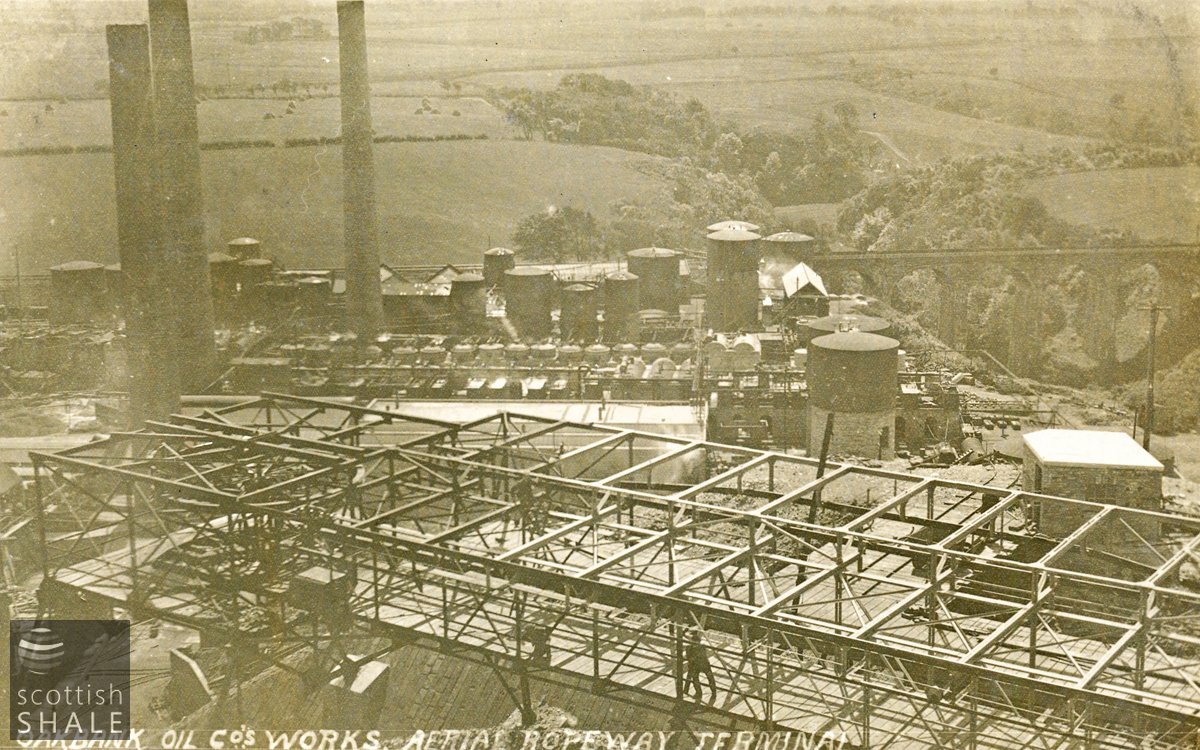
See full record, LVSAV2010.038
Recent images

View from the south towards site of works; now a container storage yard. Looking north west. April 2013.
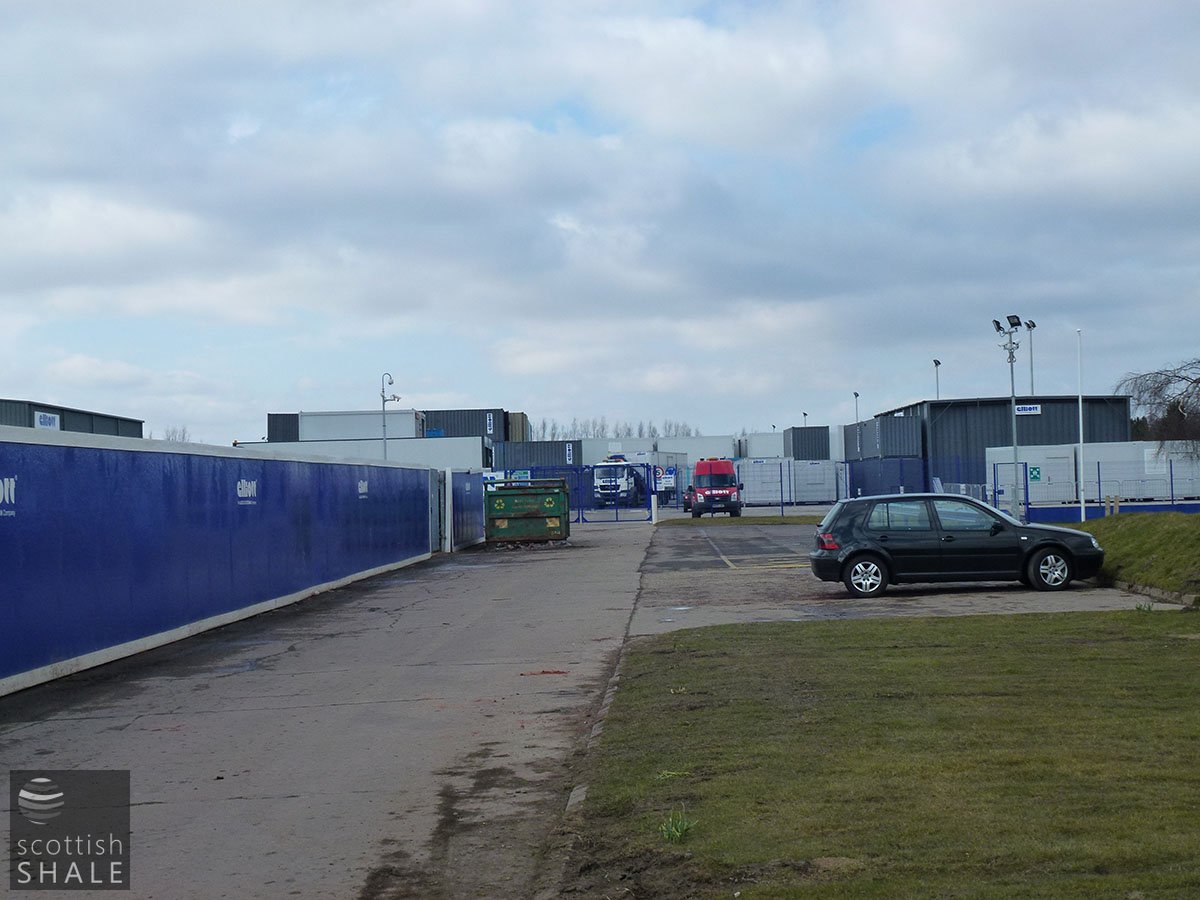
Entrance to container storage yard. Looking west. April 2013.
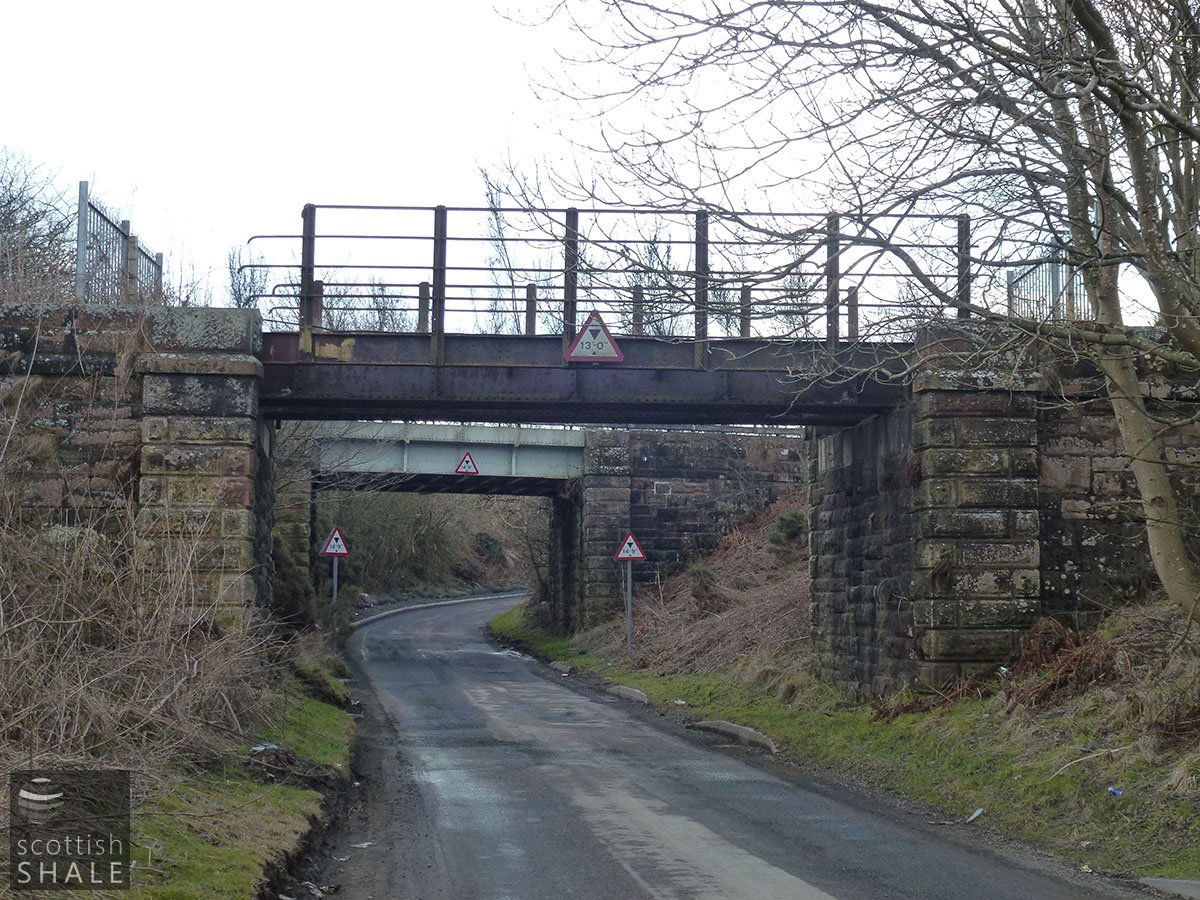
Disused bridge, formerly serving the oil works, with bridge under the Edinburgh-Glasgow via Shotts line beyond. Looking south. April 2013.
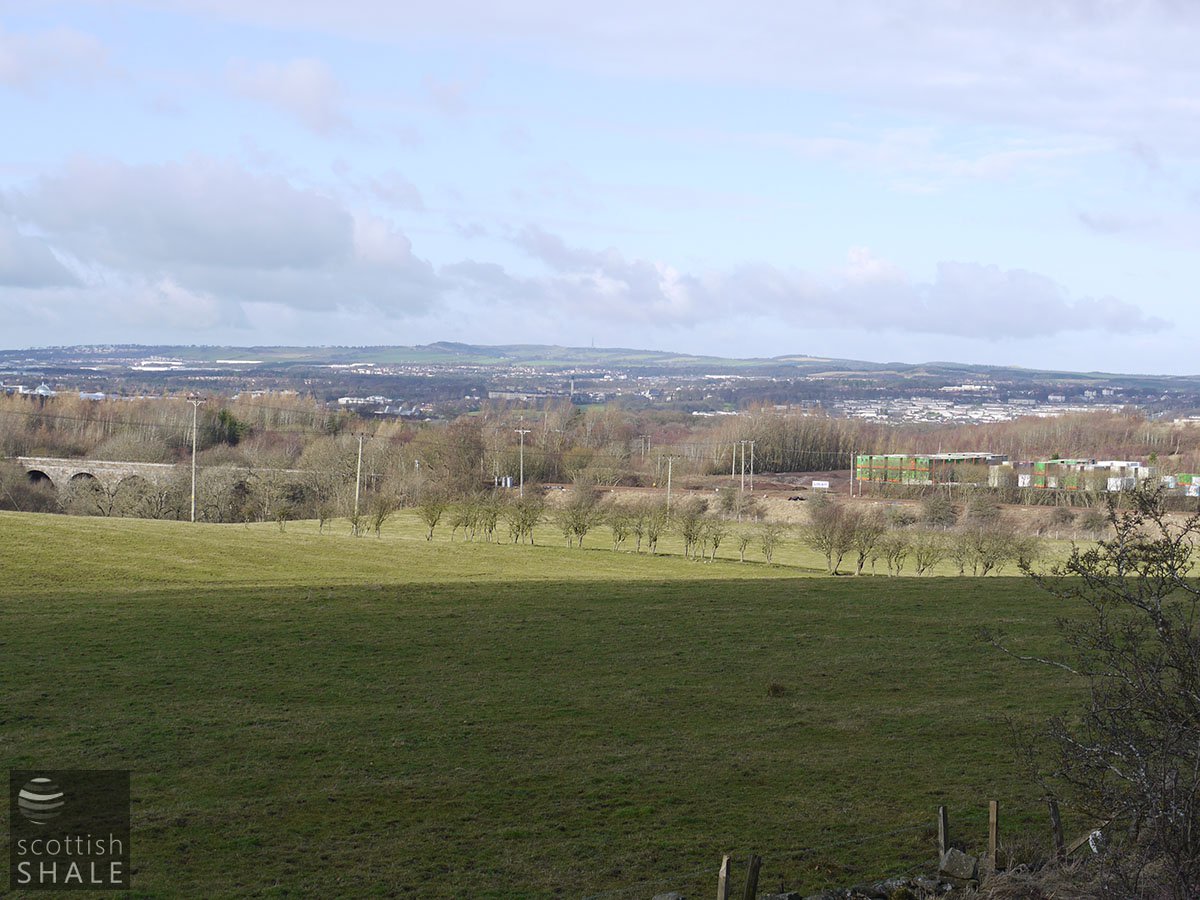
View from the south showing viaduct over the Linnhouse water. Looking north west. February 2011.
EDINBURGH GEOLOGICAL SOCIETY.—
On Saturday, this society had their fifth excursion for the summer session to Linhouse Burn and the district around Mid-Calder. …....The society next walked to Mid- Calder arid examined the operations at a shale pit which has recently been sunk, a short distance above the bridge, by the Mid-Calder Mineral Oil Company. This pit is 90 feet in depth, and contains four seams of shale varying from 20 inches to 7 feet in thickness. The company extract paraffin oil from this shale, and it yields from 30 to 40 gallons of crude oil per ton.
The society then proceeded up the Linhouse Burn, and examined the wan; seamen of sandstone and shale, all of lower carboniferous age to be found in it. Mr Smyth pointed out to the society an interesting mass of intrusive rook, consisting of felspathic trap, which crosses the channel of the stream. He stated that as the water could not cut its way through the hard igneous rock so rapidly as through the soft sandstone and shale in the channel, this trapdyke, having acted as a barrier, had been the cause of the small waterfall at the place ; and, he also added, that from the foregoing cause, the height of this waterfall will always be increasing. The society then inspected a curious old retort in the glen, which was one of the first that was used in Scotland for the manufacture of crude oil from shale.
They next examined a sandstone quarry containing good fragments of ulodcndron allaui, and they afterwards visited Oakbank Works, where the paraffin oil of the Mid-Calder Mineral Oil Company is distilled. Mr McKinlay, one of the partners of the firm, very courteously showed the members of the society the mode by which the crude oil is extracted ; and in another part of the works, he showed them the various processes by which shale spirit, burning oil, lubricating oil, and finally paraffine are obtained. He stated that from the Mid-Calder shale the company produced from 800 to 1000 gallons of crude oil per day.
North British Agriculturist 14th June 1865
.......
Midcalder Oil Works & Shale
Mr Young reported that along with Mr Moffat he had examined Mid Calder Oil Works and found there were 64 new Vertical retorts, 64 old Vertical Retorts and 21 Horizontal retorts with refining machinery to purify the crude oil made. Further that there were fully two and half million tons of shale which was easily worked probably at a cost of 6/ per ton at the retorts, but of poor quality varying from 18 to 42 gallons per ton. It was therefore resolved not to offer for the works; the greater proportion of the shale being of the lower average and a very small proportion of the higher
Meeting of the minutes of the directors meeting of Young's Paraffin Light and Mineral Oil Co. Ltd., 25th October 1867
.......
TO BE SOLD. THE OAKBANK OIL WORKS, belonging to the Mid-Calder Mineral Oil Company (Limited), together with the company's interest in the lease of the adjoining Mineral Field. The works are situated in Mid-Lothian, near the Junction of the Cleland and Midcalder and Caledonian Railways, and are connected therewith by a private line. For further details apply to Messrs MACONOCHIE, DUNCAN, & HARE, W.S.,10 Hill St Edinburgh.
Scotsman, 12th February 1868
.......
In the mail of the 1st inst. we announced that the Oakbank Paraffin Oil Works in the parish of Mid-Calder, were about to be again put in operation by a Glasgow firm. We now learn that the purchaser is Mr Fraser of Glasgow, the proprietor of the Drumcross Works, in the parish of Bathgate.
North British Daily Mail, 12th February 1869
.......
FIRE AT OAKBANK WORKS. The Managing Director reported that a serious fire had taken place at Oakbank Works early in the morning of Thursday 19th inst [October 1916]. The paraffin Wax Cooling Houses numbering six distinct buildings, and ranging from Nos. 50 to 55 on the plan of the Works were completely gutted entailing a considerable loss to plant and stock in process. There was also a considerable quantity of Assam Crude Paraffin and same refined wax (destroyed) lying in the open adjacent to the Cooling Houses, destroyed by the fire. The Loss is covered by the Coy's. [Company's] Insurance Policies, and energetic steps have been taken to have the buildings rebuilt, and new plant installed with as little delay as possible. FIRE AT OAKBANK WORKS. The Managing Director reported that the loss in connection with the fire which destroyed the Paraffin Wax Cooling Houses at Oakbank Works on 19th Oct last [1916] had been assessed under the Coy's [Company's] policies of Insurance at £7289:14/- and that of this amount the Company bears a proportion of the loss amounting to £584:5.5.
Oakbank Oil Company Limited, Directors' Minute Book, No.8, 1916-1919, pp26-27 and p35
.......
OILWORKS TO BE DISMANTLED. A BLOW TO CALDER VILLAGES.
Any hope which may have existed in the Oakbank and Calders villages with regard to the oil works at Oakbank, recently closed, has been quenched the fact that operations for the complete dismantling of the plant commenced to-day. Since the closing of the works July last year, rumours have been circulated frequently that the works site was to be utilised for various purposes—paper mills, soap works, and chemical manufactures being mentioned in this connection - but the rumours have proved unfounded, and the villagers East and Mid-Calder, Oakbank and Kirknewton, are now faced with the prospect of evacuating their homes in search of employment, the shale industry having been the chief source of employment in the district. Meantime the operations of dismantling will provide employment for about 50 workmen for some time, but 200 men, already unemployed, will require to find work outwith the Calders district.
Edinburgh Evening News, 10th May 1932
- 143295 - Disposition by British Transport Commission in favour of the Oakbank Oil Company Ltd of piece of ground within the former Oakbank Oil Works. - Disposition by British Transport Commission in favour of the Oakbank Oil Company Ltd of piece of ground 494 deimal parts of an acre within the site of the former Oakbank Oil works.. Type written. Dated 10th February 1960.; Includes plan showing area to be disponed. Scale 1" to 100'. Conveyances by the Rt. Hon. Earl of Morton in favour of the Caledonian Railway Co. [copy]. concerning land at Cleland and Midcalder for the construction of a railway.Dated 18th May 1868.
- 143268 - Disposition by BP Exploration Company (Associated Holdings) Ltd in favour of Midlothian County Council. - Disposition by BP Exploration Company (Associated Holdings) Ltd in favour of the County Council of the County of Midlothian concerning 42 acres at Oakbak, Mid Calder and 67 acres at Contentibus, Mid Calder. Dated 17th March 1970.



